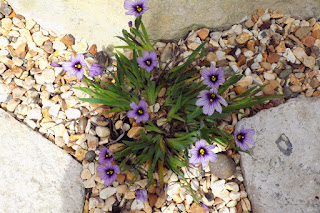 |
| acknowledgement to www.albion-prints.com |
The right opportunity arose when Piers discovered an old stone shelf as he formed the new garden shapes. It faces north-west and is about 8” deep – not exactly a theatre, but good for displaying auriculas, never the less.
I don't know anything about auriculas, so I sought out Pop's Plants, a specialist nursery on the edge of the New Forest. There we found Gill and Lesley. We made our way through their cottage and across the narrow, pretty garden to an enormous, hidden, open shed. There was a roof, but it was made of green netting to shade the plants, which were set out on extensive waist-high benches. Tiny plants as far as the eye could see – thousands of them. Gill and Lesley hold 4 national collections and raise their own plants for sale and to show.
The encounter was a delightful education! Gill told us how they raise the plants (no micro-propagation here) and breed them. The various types of plant (alpine, border, double, striped, show edged, show fancy and show selfs) and a few of the dos and don'ts. Bright but not too sunny. Moist but not too wet. We came away with 7 'easy-to-grow' 'alpines' and a 'border', two still in flower and the rest to surprise us with a range of colour next year. Another stipulation was to remove offsets in order to give a nobler, more showy plant.

I shall be experimenting with these offsets to see if I can populate the edges of the garden with these fussy little prima donnas and have them edging the paths as they would have done in the 19th century back-to-backs of Lancashire.





















